Building a shower tray with your own hands: practical tips
In this article we will talk about how to make a shower tray with your own hands from affordable and inexpensive materials using a simple construction tool. The topic of the article is relevant, since, despite the abundance of ready-made pallets for sale, the price of such products is high.
Again, only by building and trimming a shower corner with your own hands can you achieve that it is optimally combined with the interior decoration in the room. So, we found out that independent construction guarantees a number of obvious advantages, it remains to determine how and from what to build.
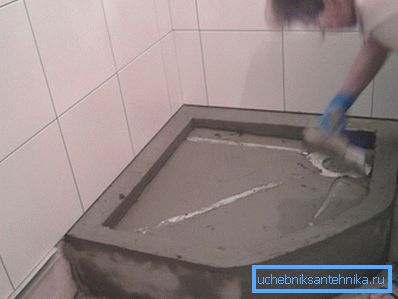
The choice of building material
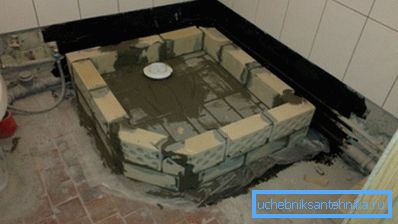
Before you make a shower tray with your own hands, you need to decide which building and finishing materials to use.
Products on sale are made of pressed steel, cast iron, acrylic, ceramics, natural stone, etc. Unfortunately, all these materials are not suitable for self-manufacturing of the pallet. The only thing from which you can independently build a bowl of a pallet, so it is from concrete, followed by lining with ceramic tiles.
The advantage of using concrete is the ability to give the cup any even the most complex shape. In addition, if when facing the bowl to use ceramic tiles, used for finishing the floor, the constructed tray and the room will be stylistically perceived as a whole.
So, we decided that we will use concrete and tiles, it remains to determine the characteristics of these materials.
Proportions of concrete
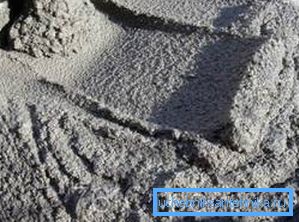
Traditionally, concrete is called a mixture of cement, sand and water with the addition of a filler. For example, in the manufacture of structures in contact with water, crushed stone is used as a filler as it is characterized by low porosity and practically does not absorb moisture.
Tip: To give the concrete product maximum hydrophobicity, at the stage of mixing, liquid glass can be added to the solution together with water. But in this case, the rate of setting of the solution is significantly accelerated.
The ratio of ingredients in the composition of the solution is determined by the brand of concrete. For example, concrete of grade 200 (most often used in individual residential construction) is made of 1 part cement, 2.6 parts of dried dry sand and 4.5 parts of crushed stone (fraction no more than 2-2.5 cm).
Portland cement with a grade of at least M400 is used for the manufacture of concrete.
Type of finishing materials used
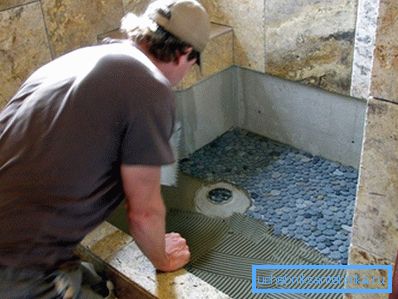
The following requirements are imposed on the tile for finishing the shower tray:
- Security - provided by a rough surface texture;
- Hydrophobicity - ensured by a low degree of porosity;
- High breaking strength - provided by a greater thickness of the material in comparison with wall tiles.
Facing materials that meet the listed criteria can be purchased at any building materials store.
Tip: Considering that the price of a tile is high, you can save money and purchase tile combat. Broken tile is much cheaper and at the same time it is much easier to lay it on surfaces with complex shapes.
Construction works
After we have decided on the choice of building and finishing materials, we will look at how the installation of the shower tray is done with our own hands. The construction of the pallet is not particularly difficult, however, it is better to plan the arrangement of the bathroom during the overhaul.
Installation instructions include the following steps:
- Prepare the base of the floor:
- To begin with, we determine the configuration and size of the bowl.
- Along the perimeter of the future pallet we remove the old floor covering, grasping about 20 cm more on each side.
- On the cleaned basis we perform waterproofing works, namely, we cover the surface with a layer of bitumen mastic.
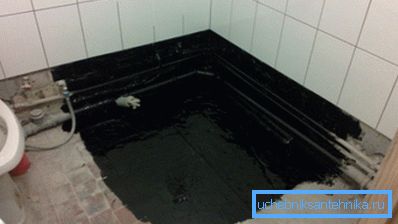
Important: If the base is old and its surface crumbles, we apply special dedusting impregnations of deep penetration, such as concrete contact, before applying the mastic. Impregnations of this type penetrate into the porous structure of concrete, polymerize there, as a result of which the thickness of the base is more dense.
- We prepare engineering communications.

Preparation of communications consists in leading the funnel pipe and in installing the ladder at the place where it is supposed to drain in the bowl.
As a drain pipe, you can use polypropylene (gray) pipes with a diameter of 50 mm. Especially under the socket of these pipes, you can pick up a siphon (ladder) which is installed directly into the concrete.
Important: Summing the sewer pipe to the drain, you need to bring them to such a height that the bowl plane has a slight slope towards the drain, and then the water will flow by gravity.
- Getting to construction:
- In the first place on a pre-prepared basis we arrange the formwork. For formwork, you can apply various sheet materials that are not susceptible to rapid destruction when in contact with water. For example, the formwork can be made of laminated plywood or fiberboard.

Considering the fact that the pallets are mostly oval or semicircular, you can use strips of old wide plastic lining for formwork. Such material bends well, and therefore the formwork can be given any shape. Moreover, the lining width of 25 cm is enough to fill a high side.
We install one wall panel opposite the other, bend it at the right angle and fix it with dowels and clamps.
- In the internal volume of the formwork lay out a reinforcing mesh of steel wire with a diameter of not less than 3 mm.
- Next, prepare the solution in accordance with the specified proportions.
- We pour the mortar in portions into the formwork and immediately level it so that it penetrates into all cavities and so that there are no voids left.
- From above, the concrete is covered with plastic wrap and left for a few days so that it grabs.
- After 2-3 days formwork disassemble.
- Prepare the solution and pour the bowl 2 cm below the level of the ramp sides.
- We cover the concrete with a film so that it does not crack and wait for 3 days. Then remove the film.
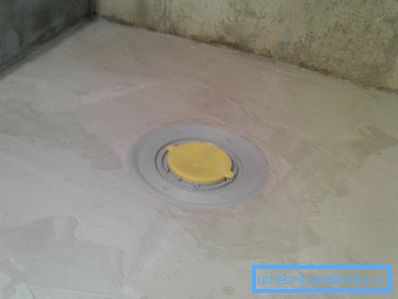
- From the sides of the constructed barrier to the edges of the drain hole, we stretch the cords, which will serve as a guide.
- Prepare a cement-sand mortar without crushed stone at the rate of 1 to 2. In the solution, knead the "liquid glass".
- On the cords with the solution we derive the inclined plane.
Important: So that the solution does not flow, make it thick.
- After the constructed bowl dries, we cover it with a thin layer of "liquid glass". As a result, the construction will be hydrophobic and the concrete will become more durable, since it will not release all the moisture out before the prescribed time.
- Tiled work.
- Apply on small areas of the pallet tile adhesive with a layer thickness of 5 mm.

- On the layer of glue lay out tile battle, so that the pieces of ceramics adjoined to each other with a gap of 2 mm.
- Immediately level the surface so that some pieces of tile do not bulge relative to the surface of other pieces.
- After the tile is laid, but the glue has not dried yet, we take a match, go through all the gaps and pull the glue out of them.
- The resulting gaps are filled with tiled grout.
Conclusion
So, we talked in detail about how to build a shower tray. Have any questions? We recommend to watch the video in this article.